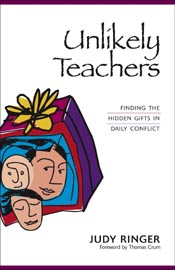| Unlikely Teachers |

SEACOAST BOOKS
The workplace can be a battleground. Your work mates are out to lunch, the customer isn’t always right and your boss doesn’t have a clue. You can fight back, or you can – breathe – and direct all that energy in more positive directions. Judy Ringer’s new book applies the principals of the ancient martial art of Aikido to conflict management. You should read this one, Grasshoppper.
Is Aikido a Key to Conflict Management?
 We don’t know Aikido from al-Qaeda, but we’ve certainly experienced the pressures of conflict at work. That’s why many of us now work from home. The ancient art of Aikido, according to black belt master Judy Ringer, is about much more than self defense. It is a form of defense that redirects aggressive energy toward solving conflict without harming the attacker. The goal here is to win by reaching a solution, rather than obliterating your opponent. Someone should send a copy to the White House.
We don’t know Aikido from al-Qaeda, but we’ve certainly experienced the pressures of conflict at work. That’s why many of us now work from home. The ancient art of Aikido, according to black belt master Judy Ringer, is about much more than self defense. It is a form of defense that redirects aggressive energy toward solving conflict without harming the attacker. The goal here is to win by reaching a solution, rather than obliterating your opponent. Someone should send a copy to the White House.
Aikido is about harmony and conflict resolution. Who could be opposed to that? But it’s hard for us humans to outmaneuver our animal instincts. Emotions tell us to fight or flee. Judy Ringer says there is a better way. It just takes a little enlightenment, and lots of practice.
We willing to learn new tricks, but we absolutely refuse to wear a martial arts robe to work. Judy says the outfit isn’t required. We asked a few more questions about this exciting new book and here’s what we learned.
SEACOASTNH: What got you started down the Aikido road?
JUDY RINGER: In 1984, I met Tom Crum, author of The Magic of Conflict. His workshop was my first introduction to Aikido and its practical applications to conflict in daily life. I got hooked by Aikido’s beauty and power and kept going back for more.
The Aikido metaphor says that the attack can be transformed into useful energy, and this made a lot of sense to me. I also appreciated that conflict is not just about theory. When conflict arises, we react physically and emotionally, and theory only goes so far in addressing these reactions. Aikido offers mind/body techniques to help us manage ourselves so that we can better manage what is coming at us. Gradually I became certified (1993) to teach Tom's Magic of Conflict approach. That's what got me onto the mat. I thought I'd better understand the approach from the ground up. And for the last few years I've been assisting with Tom's Journey to Center program in Colorado. He is a very generous teacher, mentor, and colleague. You might also check out his new book, Three Deep Breaths.
SEACOASTNH: Do I need to practice Aikido to use the techniques in the book?
JUDY RINGER: No. That's what is so fun about the book. Unlikely Teachers went through many drafts, and the first readers were people who did not practice Aikido. These readers made me spell out the metaphor and use examples that anyone could understand and use. I think it's accessible to anyone who wants to learn how to change their conflict habits.
CONTINUE JUDY RINGER INTERVIEW
JUDY RINGER ON AIKIDO (continued)
SEACOASTNH: What does a black belt in Aikido do -- compromise the enemy to death?
 JUDY RINGER: Your question made me chuckle, although what first attracted me to Aikido were the concepts of blending and redirecting - what you are probably calling compromising. With my accommodating nature, I was good at the blending. What I needed to learn was how to put my power out into the world in purposeful ways. Aikido is not about compromising at all, actually.Aikido is about finding an answer that supports all parties. Aikido is not a resistant art, but it is also not a passive art. It takes a while to learn the difference.
JUDY RINGER: Your question made me chuckle, although what first attracted me to Aikido were the concepts of blending and redirecting - what you are probably calling compromising. With my accommodating nature, I was good at the blending. What I needed to learn was how to put my power out into the world in purposeful ways. Aikido is not about compromising at all, actually.Aikido is about finding an answer that supports all parties. Aikido is not a resistant art, but it is also not a passive art. It takes a while to learn the difference.
SEACOASTNH: The concept of using negative energy to resolve conflict is intriguing, but can we really learn it from a book?
JUDRY RINGER: Great questions - all of them. Without sounding too self-serving, I think yes, we can learn the concepts from a book. And, we have to go out and practice the concepts in real life situations, in order to make them our own. I've tried to offer practices as well as real life examples from former students, so that the reader can see how one might actually do it.
SEACOASTNH: Are you also OnePoint Press? We're very interested in self publishing techniques. Can you offer details about publishing the book for readers who may want to follow suit?
JUDY RINGER: I am OnePoint Press. I began to think about self-publishing this book three years before its release in April, 2006. It was always my choice and I have learned a great many things, all of which I would be happy to share. People can email mre at the web site for more details. I'll list just a few details here:
1) If you want to publish a beautiful book that doesn't look self-published, try to find a mentor or editor to guide you in the process, someone who knows the ins and outs of the business. I had a person like this in my corner and am glad. Her name is Sonja Hakala, and she lives in West Hartford, VT.
2) You can find offset printers who will give you as good a quote as digital printers (if you are printing 1,000 or more copies). Even though digital printing has come a long way, there is a qualitative difference in the look of offset.
3) Find a good designer for the cover and interior of the book, and invest in a copy editor who knows her stuff and is detail oriented. Lots of red marks now will save you headaches later.
4) Keep at it. Find time in your schedule to write a bit each day, or each week, or whatever works with your schedule. Because my busiest workshop seasons are in the spring and fall, I primarily worked on the book in the summer and winter months. I think it helps to have a clear vision of why you're writing and how you would like the finished product to serve your audience.
SEACOASTNH: Who does your graphic design? It's gorgeous.
JUDY RINGER: I am fortunate to know Lisa Scontras Noonis She does all my graphic design. And she is amazing (and, by the way, she is also a wonderful painter). She showed me at least fourteen very different possible designs for the cover. I showed them around, got feedback, and eventually chose the one that felt the best to me. It also happened to be one that got some of the best feedback. She also created a beautiful and readable interior design that, I think, makes people want to pick up the book and read it.
BUY THE BOOK
Unlikely Teachers:
Finding the Hidden Gift in Daily Conflict
One point Press (2006)
$15, plus postage
